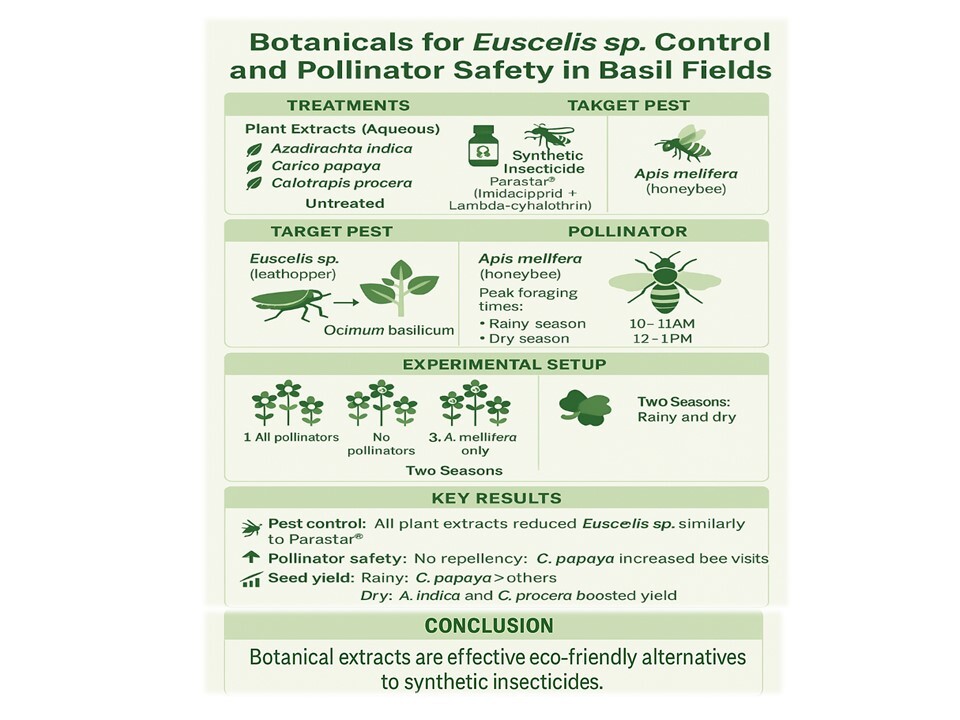ORIGINAL ARTICLE
Pesticidal activity of plant extracts as alternative to synthetic chemical insecticides to fight against Euscelis sp. and for preservation of Apis mellifera Linnaeus associated to the inflorescences of Ocimum basilicum L.
1
Department of Biological Sciences of Living Organisms, University of Garoua, Faculty of Science, Plateau, P.O. Box 346, Garoua, Cameroon
2
Department of Biological Sciences, University of Ngaoundéré, Dang, P.O. Box 454, Ngaoundéré, Cameroon
3
Department of Biological Sciences, University of Maroua, Kongola, B.O. Box 814, Maroua, Cameroon
4
Zoology Unit, Laboratory of the Biology and Physiology of Animal Organisms, University of Douala, Ange Raphaël, P.O. Box 24157, Douala, Cameroon
A - Research concept and design; B - Collection and/or assembly of data; C - Data analysis and interpretation; D - Writing the article; E - Critical revision of the article; F - Final approval of article
Submission date: 2025-03-14
Acceptance date: 2025-08-08
Online publication date: 2025-08-19
Corresponding author
DANIEL KOSINI
Department of Biological Sciences of Living Organisms, University of Garoua, Faculty of Science, Plateau, P.O. Box 346, Garoua, Cameroon
Department of Biological Sciences of Living Organisms, University of Garoua, Faculty of Science, Plateau, P.O. Box 346, Garoua, Cameroon
HIGHLIGHTS
- • Botanical extracts tested as eco-friendly alternatives to manage Euscelis sp
- • Extracts matched parastar in Euscelis sp. control, proving eco-friendly potential
- • Plant extracts boosted Apis mellifera foraging, unlike synthetic insecticides
- • Peak Apis mellifera foraging: 10–11 AM (rainy) & 12–1 PM (dry), linked to blooms
- • Botanical extracts aid pest control & pollinator safety, boosting basil seed yield
KEYWORDS
TOPICS
ABSTRACT
In recent years, researchers have increasingly focused on using secondary compounds from plant extracts as potential alternatives to synthetic insecticides, which can harm biodiversity, including pollinators. This study evaluated the effectiveness of aqueous leaf extracts from Azadirachta indica A. Juss., Carica papaya L. and Calotropis procera (Ait.) R.BR. on the population density of Euscelis sp. and the foraging behavior of Apis mellifera Linnaeus in a basil (Ocimum basilicum L.) field during both the rainy and dry seasons. Trials were carried out using a RCBD with four replications: three plant extracts x one positive control (parastar) x one negative control x four groups of flowers (1: exposed to all pollinators, 2: protected from insects, 3: exposed only to A. mellifera and 4: uncovered without insect visits). Results showed that all botanical extracts exhibited insecticidal effects comparable to parastar against Euscelis sp. Among the 11 pollinator species recorded, A. mellifera was the most frequent visitor, foraging throughout the day with activity peaking at 10–11 AM during the dry season and 12–1 PM during the rainy season. The highest abundance of A. mellifera per 1000 flowers was recorded in the C. papaya treatment, which significantly improved seed yield. These results suggest that the tested botanical extracts are promising eco-friendly alternatives for integrated pest management, helping to reduce the risks of synthetic insecticides to pollinators and enhance basil seed production.
CONFLICT OF INTEREST
The authors have declared that no conflict of interests exist.
Share
We process personal data collected when visiting the website. The function of obtaining information about users and their behavior is carried out by voluntarily entered information in forms and saving cookies in end devices. Data, including cookies, are used to provide services, improve the user experience and to analyze the traffic in accordance with the Privacy policy. Data are also collected and processed by Google Analytics tool (more).
You can change cookies settings in your browser. Restricted use of cookies in the browser configuration may affect some functionalities of the website.
You can change cookies settings in your browser. Restricted use of cookies in the browser configuration may affect some functionalities of the website.




